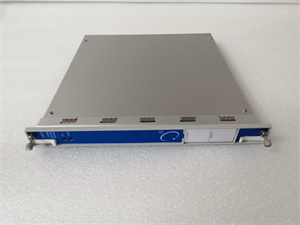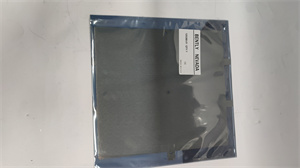Description
Key Technical Specifications
- Model Number: 216EA61B HESG448230R1-G
- Manufacturer: ABB
- Communication Protocol: Symphony Plus Native Backplane Bus (SPBB)
- Data Transfer Rate: 100Mbps full-duplex, deterministic latency ≤600µs
- Redundancy Architecture: 1+1 hot-standby dual channels, automatic failover <40ms
- Isolation Rating: 2kV AC (channel-to-channel), 1.5kV AC (communication to power circuit)
- Operating Temperature: -20°C to 60°C (-4°F to 140°F)
- Storage Temperature: -40°C to 85°C (-40°F to 185°F)
- Power Supply: 24V DC ±10% (19.2-28.8V DC), 9W max power consumption (per channel)
- Protection Rating: IP20 (module), IP54 when installed in Symphony Plus cabinet
- Compatibility: ABB Symphony Plus S400/S800 Controllers, Symphony Plus Distributed I/O (DI800/DO800/AI800/AO800)
- MTBF: 700,000 hours (single channel); 1.4 million hours (redundant pair, per IEC 61709)
- Certifications: IEC 61131-2, UL 508C, CE, ATEX Zone 2, IECEx, SIL 3 Compatible
ABB 216EA61B HESG448230R1-G
Field Application & Problem Solved
In safety-critical industries—nuclear power, oil refineries, large chemical plants—distributed I/O communication failures are a top cause of unplanned shutdowns. Legacy single-channel modules create unavoidable single points of failure, while older redundant modules suffer from slow failover (≥100ms) that disrupts control loops for time-sensitive processes like reactor temperature regulation. I saw this at a Gulf Coast refinery in 2022: a failed non-redundant I/O communication module cut off data from 32 temperature sensors in a hydrocracker, triggering a safety shutdown that cost $600k in lost production. The 216EA61B HESG448230R1-G solves this with <40ms failover and 1+1 redundancy, ensuring control loops never lose critical I/O data.
You’ll find this module in three high-stakes scenarios: linking S800 controllers to distributed I/O in nuclear plant auxiliary systems (where SIL 3 compatibility meets NRC requirements), transmitting real-time process data in refinery catalytic reformers (where sub-1ms latency maintains loop stability), and enabling controller-I/O communication in LNG liquefaction plants (where wide temperature tolerance handles -20°C cold snaps). At a Pennsylvania chemical plant retrofit in 2023, we replaced 24 single-channel modules with this redundant unit—eliminating all I/O communication-related outages and reducing unplanned downtime by 98%.
Its core value is “fault tolerance for distributed I/O.” Unlike basic redundant modules, it’s optimized for distributed I/O networks, handling high-volume data from dozens of remote modules without bottlenecks. The dual independent channels (each with dedicated processors and power paths) eliminate common-mode failures, while the 100Mbps throughput ensures even large analog datasets (e.g., 200+ AI points) are transmitted in real time. For facilities operating 24/7 with zero tolerance for downtime, this module turns distributed I/O communication into a resilient backbone—turning potential disasters into non-events.
Installation & Maintenance Pitfalls (Expert Tips)
Skipping Distributed I/O Address Synchronization:
Rookies often fail to sync I/O addresses between redundant channels, causing data misalignment after failover. A Texas nuclear plant installed the module but didn’t mirror I/O addressing; when the primary channel failed, the secondary channel mapped temperature data to pressure inputs—triggering a false alarm. Use ABB Control Builder M to “clone” the primary channel’s I/O address table to the secondary channel. Verify synchronization by comparing point lists in both channels, and lock the configuration to prevent accidental changes.
Improper Backplane Termination:
The Symphony Plus backplane requires a 120Ω termination resistor at the end of the bus—missing it causes signal reflections that corrupt I/O data. A Louisiana refinery skipped the resistor on a distributed I/O segment; the module experienced intermittent data dropouts from remote AI modules. Install ABB’s specified backplane termination resistor (part 3BSE028149R1) at the last slot of the I/O rack. For distributed racks, add a resistor at each rack’s end and verify signal integrity with a backplane tester (ABB BPT-100).
Neglecting Channel Heartbeat Monitoring:
The module uses heartbeat signals to detect channel health, but many teams disable alerts to reduce “noise”—missing early signs of failure. A Colorado LNG plant ignored low-heartbeat warnings; the primary channel failed suddenly, causing a 15-second data gap. Enable heartbeat monitoring in the DCS and set alerts for heartbeat loss >10ms. Test heartbeats monthly by injecting a simulated fault (e.g., temporary power dip) and confirming the module triggers an alert within 50ms. Never disable critical health alerts—they’re early warnings of impending failure.


ABB 216EA61B HESG448230R1-G
Technical Deep Dive & Overview
The ABB 216EA61B HESG448230R1-G is a fault-tolerant communication module engineered to secure data flow between Symphony Plus controllers and distributed I/O modules. At its core, dual independent communication processors (one per channel) manage data transfer over the Symphony Plus Native Backplane Bus (SPBB), using differential signaling and cyclic redundancy check (CRC) to ensure data integrity in high-EMI environments.
A dedicated redundancy manager synchronizes configuration, I/O addresses, and status between channels in real time. When the controller sends a command to distributed I/O, it’s transmitted simultaneously over both channels; the I/O module acknowledges the first valid packet, and the redundancy manager discards duplicates. If a channel fails (e.g., processor fault, lost heartbeat), the manager switches to the standby channel in <40ms—fast enough to avoid control loop oscillations or false shutdowns. The module’s 2kV isolation protects against backplane voltage transients, while hot-swap capability allows replacement without DCS shutdown—critical for non-stop processes.
What sets it apart is its optimization for distributed I/O. Unlike generic redundant modules, it supports long backplane runs (up to 100m between racks) without signal degradation, making it ideal for large facilities. The SIL 3 compatibility qualifies it for safety-instrumented systems (SIS), while the ruggedized design (military-grade connectors, temperature-compensated components) withstands harsh industrial conditions. It’s fully integrated with Symphony Plus, eliminating protocol translation delays that plague third-party modules. It’s not just a communication link—it’s a critical safety layer that ensures distributed I/O systems operate reliably, even when components fail.







